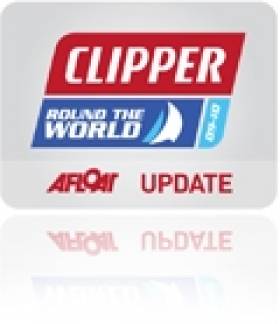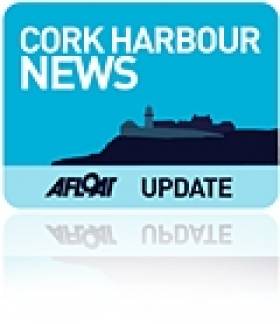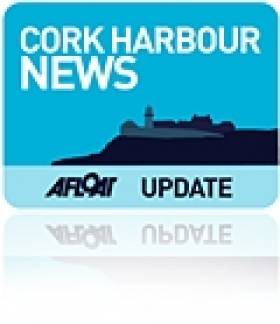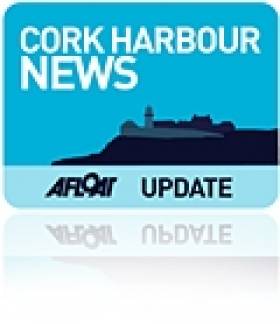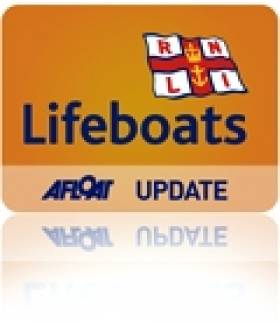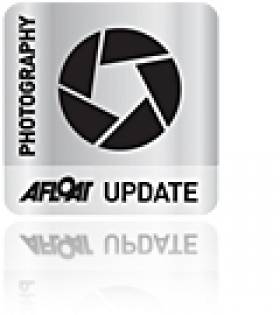Displaying items by tag: Cork Harbour
Cork Heads for Home in Clipper Race
At 1615 local time (1915 GMT) Cork, Ireland, crossed the start line at Royal Cape Breton Yacht Club to begin the 2,075 mile race to Kinsale. The team, led by Hannah Jenner, has 48 hours to build the biggest possible lead before the fleet of nine Clipper 68s starts to hunt them down. For the first time in the Clipper round the world yacht Race’s history this will be a pursuit race after the original Clipper 68 was lost when Cork hit a submerged reef in the Java Sea last January.
Race start for Cork followed the usual procedure and crews from the nine remaining boats lined the rails of their yachts to cheer their friends out to sea. A team from the Fortress of Louisbourg primed their 8lb replica cannon and, after the ten and four and one-minute preparation signals, fired it to unleash the yacht towards the waiting ocean.
The Challenge 67 that the team is now sailing is slightly shorter and also heavier, so the fleet is racing under IRC handicap rules. For Race 12 that handicap is being applied up front, hence their departure from Cape Breton Island today, rather than with the rest of the fleet on Saturday afternoon.
Cork’s crew almost immediately changed up from their yankee headsails to a mid-weight spinnaker to take full advantage of the ten knots of breeze.
Irish crew member Kevin Austen shared his thoughts prior to the boat departing, saying, “This Atlantic crossing is a nice big carrot at the end of the stick and we are looking forward to pushing her hard and bringing her home. The concept of the pursuit race is really interesting; the next 48 hours will be pedal to the metal, keep her moving to get as much space between us and the pursuers. The weather gods have not been on our side in the last couple of races but we have already shown that we can be competitive. We are hoping to show that properly now and push fast and hard across the last great ocean crossing of this race.”
The others are really looking forward to the moment the team makes landfall on the other side of the Atlantic, including County Kerry resident, Jacqui Browne.
“When I see Ireland for the first time, you will probably never see such a big smile, ever, on a person’s face,” she says. “I’ll have the biggest grin I have ever worn! Even this morning, seeing the routing chart and seeing the straight line across the Atlantic, it makes home feel very close.”
Before they slipped their mooring lines, the team was invited to a send-off reception at which Burton MacIntyre, a local step dance teacher who will be coming to the stopover in Kinsale and Cork with the Cape Breton Island delegation, put the crew through their paces. For many of the team arriving in Ireland will mark their return home after almost a year away and a quick brush up on their dancing skills in readiness for a huge party in Kinsale was deemed essential. Burton promised to be on the quay side to greet the team when they arrive after the final major ocean crossing of the Clipper 09-10 Race.
He won’t be alone – the Cork crew members already have big plans for celebrating their homecoming and supporters will be there in large numbers.
Kevin says, “My mother has a few plans for Cork but it’s easier getting a line up for a music festival early on as it is to get the plans out of my Mum! I have heard talk of a big barbecue. They will all be in Kinsale; my friends – the two Tims, Luke and Neil and all of my mates will be down. They’ve rented a house in Kinsale and it should be a massive big party.”
Jacqui will also have a sizeable group of supporters waiting to cheer her in as she arrives home. “It will be really emotional but for now it’s excitement at the anticipation of seeing friends and family that I know will be waiting at the quayside and I’m really looking forward to seeing them and hearing them screaming and roaring out my name. I would expect at least 50 to 60 people that I know will be there – people from Cork and Kerry plus many of the Cork crew who have sailed on previous legs. It’s going to be one big happy party.
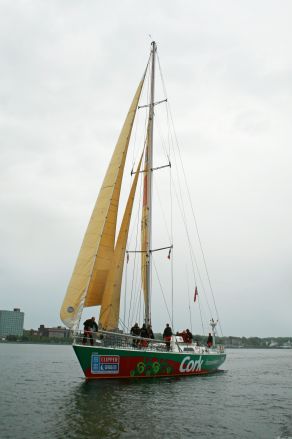
“I am particularly proud of this boat because I went out to Antigua to collect her and work on her and now I’m bringing her home to Cork. That has always been our huge ambition, as the Cork team, to bring her in to Cork – hopefully in first place.”
Skipper Hannah Jenner knows she has the team that can do that, and that starting ahead of the rest of the pack could give them a slight psychological edge.
“It really depends on what happens with the weather because the first 24 hours are going to be quite difficult,” she explains. “It looks like potentially there’s going to be light winds from a lot of different directions so it’ll either be good for us going out there, getting into reasonable wind and knowing we’re getting ahead or its going to be a really stressful night as we go slowly and nervously look at the clock as it counts down to the time when the others start. So, fingers crossed for the good wind and good boat speed and we’ve just got to keep it.
“The boat’s fine in heavy airs and we’re competitive under the handicap in heavy airs but if the wind drops under 15 knots it becomes a nervous time for us. So we’re hoping for that breeze that keeps us ahead and that we can get far enough ahead and into new breeze that’s due to fill in around the time the rest of the guys start so that we can keep moving when they’re moving.”
The other nine yachts of the Clipper fleet will leave Sydney, Cape Breton Island, on Saturday 19 June and they and Cork are due to arrive in Kinsale between 1 and 4 July for an eight day festival there and in Cork City. For more information on the festival programme, visit www.corkclipperfestival.com.
Aerial footage of Cork Harbour below.
Spike Island Will Open to Tourists
The first visitors to Spike Island this summer will be given walking tours of the new tourism attraction Cork County council says. The island in the middle of Cork harbour is the subject of proposals to develop it as a major tourism resource in the harbour. More here.
New Cork Harbour Park Contract
Cork City Council is inviting interest in the design of a new 32 hectare park for Cork Docklands. The full details of the 'new island district' are here.
Port of Cork Selects Ringaskiddy as Terminal Site
Port of Cork announced yesterday a site in Ringaskiddy in Cork Harbour would be the most suitable site for the development of its shipping container business. The new site will by adjacent to the existing ferry terminal. A full report is in today's Irish Times by Barry Roche here.
Crosshaven Lifeboat Rescues 18-foot Yacht
Crosshaven RNLI Lifeboat went to the aid of an eighteen foot yacht on passage from the Kinsale area to Crosshaven this evening. The yacht with two persons on board suffered mechanical failure and was having trouble making way into a headwind.
Initially, the yacht was assisted by the motor Cruiser “Callie” who took them on initial tow and informed the Coastguard in Valentia who made the decision to Launch the Crosshaven lifeboat at 7pm. The Volunteer crew made up of Helm Con Crowley with Vincent Fleming and Ritchie Kelleher made their way to the rendezvous between the Cork Bouy and Rennies Point and relieved the motor cruiser of the tow. Crewman Ritchie Kelleher
Boarded the yacht and helped rig the tow for the 40 minute journey back to Crosshaven where the yacht was secured.
Aerial Footage Goes Online
Welcome to Afloat TV

Since 2003 the team behind Afloat magazine has also been producing high-end, internationally appealing and entertaining factual documentaries on the Irish waterways. The production team are a mix of creative, technical and business people whose expertise guarantees an innovative approach to production and a high-quality finished product. The focus is on marine based programmes which entertain and educate. The work has been broadcast on RTE One and internationally on Sky Channels.
The Bay
Screened on RTE One in 2005.
Take a trip around the one half of Ireland's capital city you probably know the least. A new four-part documentary series, The Bay will be screened over four consecutive Wednesdays in May. Using spectacular aerial and underwater footage, the series features a combination of personality-led interviews and themes to tell the story of Dublin's unique waterway. Dublin Bay stretches over six kilometres, from Howth Head on its northern tip to Dalkey Island in the south. It's a place most Dubliners simply take for granted, and one of the capital's least visited places. But there's more going on out there than you'd imagine. And that's why The Bay was made. The series introduces viewers to the rich diversity of activities and personalities around the bay, while also touching on the serious environmental and political issues facing it. Find out more about the bay here.
The Harbour
Screened on RTE One in 2007.
It’s one of the largest natural harbours in the world – and those living near Cork Harbour insist that it’s also one of the most interesting. This was the last port of call for the most famous liner in history, the Titanic, but it has been transformed into a centre for chemical and pharmaceutical industry. Giraffe wander along its shores, from which tens of thousands of men and women left Ireland, most of them never to return. The harbour is home to the oldest yacht club in the world, and to the Irish Navy. This deep waterway has also become a vital cog in the Irish economy. ‘The Harbour’ is not a history programme, nor is it a news focus. It’s simply an exploration of this famous waterway, its colour and its characters. Find out more about the harbour here.
The Estuary
Screened on RTE One in 2007.
The story of the Shannon estuary might well be one of neglect, except that against the odds this waterway has become one of Ireland's greatest natural resources. Windswept, sitting on the edge of the Atlantic, often ignored by the nation. The story of the Shannon estuary might well be one of neglect, except that against the odds this waterway has become one of Ireland's greatest natural resources. A new four-part documentary series, from the makers of RTÉ's The Bay and The Harbour series, uncovers the secrets of the Shannon Estuary. From flying boats to film-making, wildlife to wind-farms, the series reveals how a 100km-stretch of the Shannon waterway has become a hotbed for innovation in Ireland. Up to 40% of Irish energy needs are met here, on the shores of a waterway that is also home to Ireland's second largest airport, a 10,000 student university and a massive cargo port. Ireland - and the world - has learned from the estuary. The first duty free shop was opened here, along with the first industrial free zone. Over the years, thousands of business and political leaders from across the globe have come to Shannon to discover its secret - in the hope that they might copy it. Long before Ireland heard of green energy, this place was producing it. Listen in to dolphin conversations beneath the Shannon's waterline. Uncover the mystery of the Ark, the church on wheels built by a priest who prayed when the tide went out. Narrated by Brenda Fricker, the series aired on Friday nights at 7.30pm on RTÉ One from May 4th 2007. Find out more about the estuary here.
The Navy
Screened on RTE One in 2007.
60 years of the Irish Naval Service. Celebrating the 60th anniversary of the Irish Naval Service, this 3 x half-long feature documentary shows how the Service has evolved into a multi-tasking, multi-disciplinary force. Most Irish people rarely come into contact with the Naval Service, and so are unaware of the range of activities it undertakes. This documentary provides an ideal opportunity to reveal the full extent of the Service’s duties – and the commitment of those who serve on Ireland’s fleet.
The Regattas
Screened on RTE One, 2007 and Sky Sports in 2009.
Sailing featured in RTE’s Christmas schedules this year, with the broadcast of a half-hour documentary feature on the Volvo Dun Laoghaire Regatta 2007. The production, entitled ‘The Regatta’, was shot over four days in Dublin Bay during this year’s regatta. Made by Baily Films, the company behind earlier critically-acclaimed water-based documentaries The Bay, The Harbour, The Estuary and The Navy, it features spectacular on-board footage from a range of craft competing in the event. The Regatta takes viewers both on board the competing craft, and behind the scenes, to examine the challenges thrown up by organising such a large-scale event on the bay. The Regatta was broadcast on RTE 1 on Saturday, December 22, at 4.20pm.
IN DEVELOPMENT
Afloat TV projects at an advanced stage of development include:
The Edge of Ireland
Ireland’s attitude to the seas that surround her is one of the most curious in the world. An island nation, with more coastline than most other European nations, most of her citizens look inland.
Yet no-one in Ireland lives further than 100 kilometres from the sea, and the majority of the population are housed within 10 kilometres of the coast.
More than any other European nation, our history is written on our shores. The very first settlers clung to it, fearing to explore inland. The shores fed and sustained them, and continued to sustain communities from Malin Head to Mizen Head for the next 9,000 years.
From the fort of Dun Aengus to the fields at Carnsore Point, from Inishvickillane to Bull Island, the coastline holds a key to our understanding of Ireland and ourselves.
The Edge of Ireland will uncover that hidden history of Ireland, and explore what the future holds for our coastline. Travelling around the coast, it will use local and national experts to relate individual accounts of how the sea has connected with the land to shape a local community or the nation at large.
The six half-hour series will be presented thematically, rather than using a linear journey up and down the coastline.
CONTACT
If you're keen on promoting Ireland's waterways and would like to get involved with Afloat TV please email us here.
Cork Harbour Property with Deep Water Jetty Goes On Sale
The Marina Point Complex in Cobh, Cork Harbour is for sale. The 114–acre property includes the former IFI plant that runs on to the waterfront with a deep water jetty. No purchase price is quoted but it is understood that in early 2008 a purcahse price of Euro 40 million was suggested. The property is for sale in one or more lots.


























